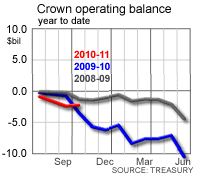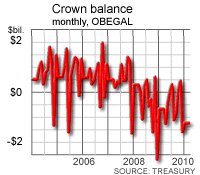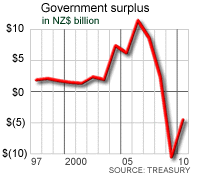 Reduced revenue, increased expenses, and losses recorded in the year to June 30, 2009 have resulted in an operating deficit of $10.5 billion for the New Zealand government, Treasury said today. (Update 3 with more on guarantee provisions.)
The NZ$10.5 billion deficit was the largest ever recorded by the Crown. It compared to a forecast deficit of NZ$9.3 billion at the time of the 2009 budget in May and a surplus of NZ$2.4 billion recorded last year.
The government's accounts for the year included a provision of NZ$816 million for further defaults under the deposit guarantee scheme by institutions that hold less than NZ$5 billion in deposits. Defaults up until now have been covered by revenue earned through the scheme's fees.
Finance Minister Bill English said tax revenue was down NZ$2 billion from last year as profits declined and tax cuts took effect. The tax take was down by approximately NZ$3 billion, but this was offset by the 'structured finance transaction' cases the IRD was fighting with the major banks in the High court.
"Based on a High Court ruling for one structured finance case, all similar structured finance assessments have been recognised as revenue in the 2009 financial year (NZ$1.4 billion)," Treasury said. The one case involved BNZ, which is appealing the ruling. The High court also ruled in favour of the IRD in a similar case against Westpac earlier this month.
Reduced revenue, increased expenses, and losses recorded in the year to June 30, 2009 have resulted in an operating deficit of $10.5 billion for the New Zealand government, Treasury said today. (Update 3 with more on guarantee provisions.)
The NZ$10.5 billion deficit was the largest ever recorded by the Crown. It compared to a forecast deficit of NZ$9.3 billion at the time of the 2009 budget in May and a surplus of NZ$2.4 billion recorded last year.
The government's accounts for the year included a provision of NZ$816 million for further defaults under the deposit guarantee scheme by institutions that hold less than NZ$5 billion in deposits. Defaults up until now have been covered by revenue earned through the scheme's fees.
Finance Minister Bill English said tax revenue was down NZ$2 billion from last year as profits declined and tax cuts took effect. The tax take was down by approximately NZ$3 billion, but this was offset by the 'structured finance transaction' cases the IRD was fighting with the major banks in the High court.
"Based on a High Court ruling for one structured finance case, all similar structured finance assessments have been recognised as revenue in the 2009 financial year (NZ$1.4 billion)," Treasury said. The one case involved BNZ, which is appealing the ruling. The High court also ruled in favour of the IRD in a similar case against Westpac earlier this month.
 "At the same time, core government expenses have increased sharply, by NZ$7 billion in the past year," English said.
"This is in part due to the greater costs of providing welfare benefits and health and education services. It also reflects a recognition that future repayments of taxes and student loans will be later and, in some cases, less than originally estimated," he said.
"The value of our large investment portfolios held in the New Zealand Superannuation Fund and the Accident Compensation Corporation has declined while our borrowings and long term liabilities have increased."
The superannuation fund (or Cullen fund as it is widely known) reported an operating deficit of NZ$2.8 billion for the year.
English said the accounts included a provisions for further default actions under the government's deposit guarantee scheme of just over NZ$800 million.
"At the same time, core government expenses have increased sharply, by NZ$7 billion in the past year," English said.
"This is in part due to the greater costs of providing welfare benefits and health and education services. It also reflects a recognition that future repayments of taxes and student loans will be later and, in some cases, less than originally estimated," he said.
"The value of our large investment portfolios held in the New Zealand Superannuation Fund and the Accident Compensation Corporation has declined while our borrowings and long term liabilities have increased."
The superannuation fund (or Cullen fund as it is widely known) reported an operating deficit of NZ$2.8 billion for the year.
English said the accounts included a provisions for further default actions under the government's deposit guarantee scheme of just over NZ$800 million.
 "The deposit guarantee schemes, a direct result of the emerging international financial crisis, were introduced to retain confidence in New Zealand's financial sector. While these schemes have been successful in meeting that objective, they have come with some cost," he said.
"To date the expected losses from entities in default have been covered by the revenue generated by the schemes. However, risk assessments carried out at 30 June estimated the likelihood of further default actions at just over $800 million, which has been provided for in these accounts."
Here are further comments from Treasury on the large provision (note 30, pg 118 in the accounts below). The provision has been made entirely for institutions that hold less than NZ$5 billion in deposits. A provision has been made both when guarantees have been triggered and to provide for losses that are more likely than not to occur, Treasury said.
The provision was made on the basis of the scheme ending on October 12, 2010 (which it would have done at June 30, 2009). However, Treasury said the decision to extend the scheme until the end of 2011 would be unlikely to significantly impact the amount of the provision:
"The deposit guarantee schemes, a direct result of the emerging international financial crisis, were introduced to retain confidence in New Zealand's financial sector. While these schemes have been successful in meeting that objective, they have come with some cost," he said.
"To date the expected losses from entities in default have been covered by the revenue generated by the schemes. However, risk assessments carried out at 30 June estimated the likelihood of further default actions at just over $800 million, which has been provided for in these accounts."
Here are further comments from Treasury on the large provision (note 30, pg 118 in the accounts below). The provision has been made entirely for institutions that hold less than NZ$5 billion in deposits. A provision has been made both when guarantees have been triggered and to provide for losses that are more likely than not to occur, Treasury said.
The provision was made on the basis of the scheme ending on October 12, 2010 (which it would have done at June 30, 2009). However, Treasury said the decision to extend the scheme until the end of 2011 would be unlikely to significantly impact the amount of the provision:
As at 30 June 2009, 73 financial institutions had joined the scheme and deposits totalling $124.2 billion had been guaranteed. This is the maximum exposure and does not include any offset resulting from the recovery of the remaining assets of the financial institution in the event the guarantee is called upon. The Crown assesses the potential loss to be associated with the entities that hold significant deposits (ie, greater than $5 billion) as being remote. It is recognising the revenue received from these institutions over the guarantee period and has made no provision for any loss associated with these entities. For other entities within the scheme (ie, entities that hold deposits less than $5 billion) a provision has been made both when guarantees have been triggered and to provide for losses that are more likely than not to occur. Guarantees have been triggered for two entities and the estimated cost of $34 million associated with these guarantees has been included in the statement of financial performance. The Crown also continually updates the likelihood of further default actions triggering the guarantee and assesses the expected loss given default. Based on these assessments, the Crown has provided for $816 million as at 30 June 2009 for future payments under this scheme. The provision has been made applying the assumption that the Retail Deposit Guarantee Scheme will finish in October 2010, the policy position as at 30 June 2009. The policy decision to extend and amend the Retail Deposit Guarantee Scheme announced on Tuesday 25 August 2009 represents a change in conditions that arose after the reporting period, it has not led to an adjustment of the provision. This decision would however be unlikely to significantly impact the amount of the provision. While the provision represents a best estimate of likely loss, a significant range of outcomes are possible under the scheme in terms of which entities may default and the eventual loss to the Crown following an event of default. This reflects the significant uncertainty as to the value that can be realised from an entity's assets following an event of default. Except as provided on the Treasury web site, further information on the Retail Deposit Guarantee Scheme cannot be provided due to commercial sensitivity.Treasury said that for the first time since 1999 the net worth of the Crown declined. Here are Treasury's comments on the government's financial year:
Both the recession and past policy decisions have had a significant effect on the Crown's fiscal position "¦ The recent recession has resulted in both decreases in revenue and increases in expenses. In comparison to the previous year, the major impacts are as follows: "¢ declining corporate and individual profits and interest rates have reduced tax revenue "¢ the introduction of the retail guarantee scheme in relation to financial institution deposits has resulted in an estimated cost to the Crown of $0.8 billion in the current year "¢ the value of the Crown's tax receivable and student loan assets have declined as future recovery of monies is predicted to be less or later than previously estimated "¢ significant losses have been sustained in a number of the Crown's investment portfolios. In particular the New Zealand Superannuation Fund (NZS Fund) reported an operating deficit of $2.8 billion for the year, and "¢ unemployment benefit expenses increased by $0.1 billion from $0.5 billion last year to $0.6 billion this year. A number of current policies have also had an impact on the result when compared to the previous year: "¢ personal and corporate tax cuts, along with the introduction of measures to help small and medium-sized enterprises, have reduced tax revenue by approximately $3 billion "¢ additional spending announced in the 2008 Budget Economic and Fiscal Update (particularly in the areas of health and education) have contributed to an increase in expenses "¢ the annual inflation-indexation of welfare benefit payments, along with beneficiary growth in areas such as New Zealand superannuation, were contributing factors to an increase in social security and welfare expenses of approximately $1.4 billion (excluding unemployment benefits) "¢ the purchase of KiwiRail (in July 2008) resulted in a write-down of $0.3 billion, and "¢ the value of the Accident Compensation Corporation (ACC) claims liability increased by $5.8 billion since last year1. A large portion of this increase resulted from the 30 June 2009 actuarial valuation (an actuarial loss of $4.5 billion was recorded). Significant factors in this actuarial loss were increases in predicted medical and rehabilitation costs along with a decrease in the discount rate used to calculate the present value of expected payments. ... however, this has been partially offset by some one-off revenue "¦ The decline in tax revenue was partially offset by recognition of tax revenue in relation to the tax treatment of certain structured finance transactions. Based on a High Court ruling for one structured finance case, all similar structured finance assessments have been recognised as revenue in the 2009 financial year ($1.4 billion). "¦ resulting in an operating deficit ... Reduced revenue, increased expenses, and losses recorded this year have resulted in an operating deficit of $10.5 billion. This compares to a 2009 Budget forecast deficit of $9.3 billion and a surplus of $2.4 billion last year. "¦ and cash deficits which must be funded by an increase in debt"¦ The lower revenue and higher expenses have resulted in a residual cash deficit of $8.6 billion. This deficit has been funded by an increase in net debt. As a result net debt rose during the year by $6.9 billion to $17.1 billion (9.5% of GDP). "¦ and a reduction in the Crown's net worth. The operating deficit is the main contributor to a decline in net worth from $105.5 billion last year to $99.5 billion as at 30 June 2009.Here are the government accounts for the year ended June 30 2009. We welcome readers' insights and comments on them. Govt Accounts June 30 2009

We welcome your comments below. If you are not already registered, please register to comment
Remember we welcome robust, respectful and insightful debate. We don't welcome abusive or defamatory comments and will de-register those repeatedly making such comments. Our current comment policy is here.